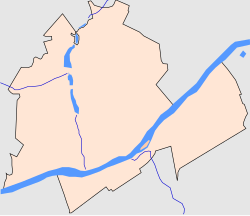| Red Synagogue of Jonava | |
|---|---|
Lithuanian: Jonavos raudonoji sinagoga | |
 The former synagogue, in 1880 | |
| Religion | |
| Affiliation | Judaism (former) |
| Ecclesiastical or organisational status | Synagogue (former) |
| Status | Destroyed |
| Location | |
| Location | Jonava, Kaunas District Municipality |
| Country | Lithuania |
Location of the destroyed synagogue in Jonava | |
| Geographic coordinates | 55°04′09″N24°16′20″E / 55.06917°N 24.27222°E |
| Architecture | |
| Type | Synagogue architecture |
| Destroyed | 1941 |
| Materials | Brick |
The Red Synagogue of Jonava (Lithuanian : Jonavos raudonoji sinagoga), also Beit Knesset Hagadol (Lithuanian : Jonavos Beit Knesset Hagadol sinagoga), was a former Jewish congregation and synagogue, that was located in Jonava, in the Kaunas District Municipality of Lithuania. The building operated as a synagogue until it was destroyed by Nazis in 1941, during World War II.
